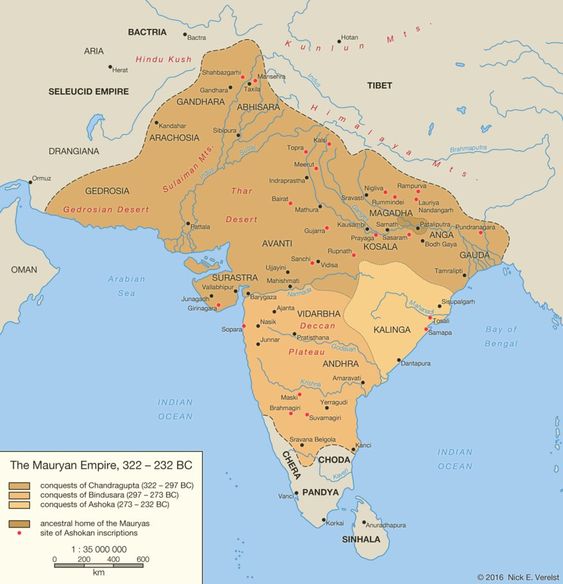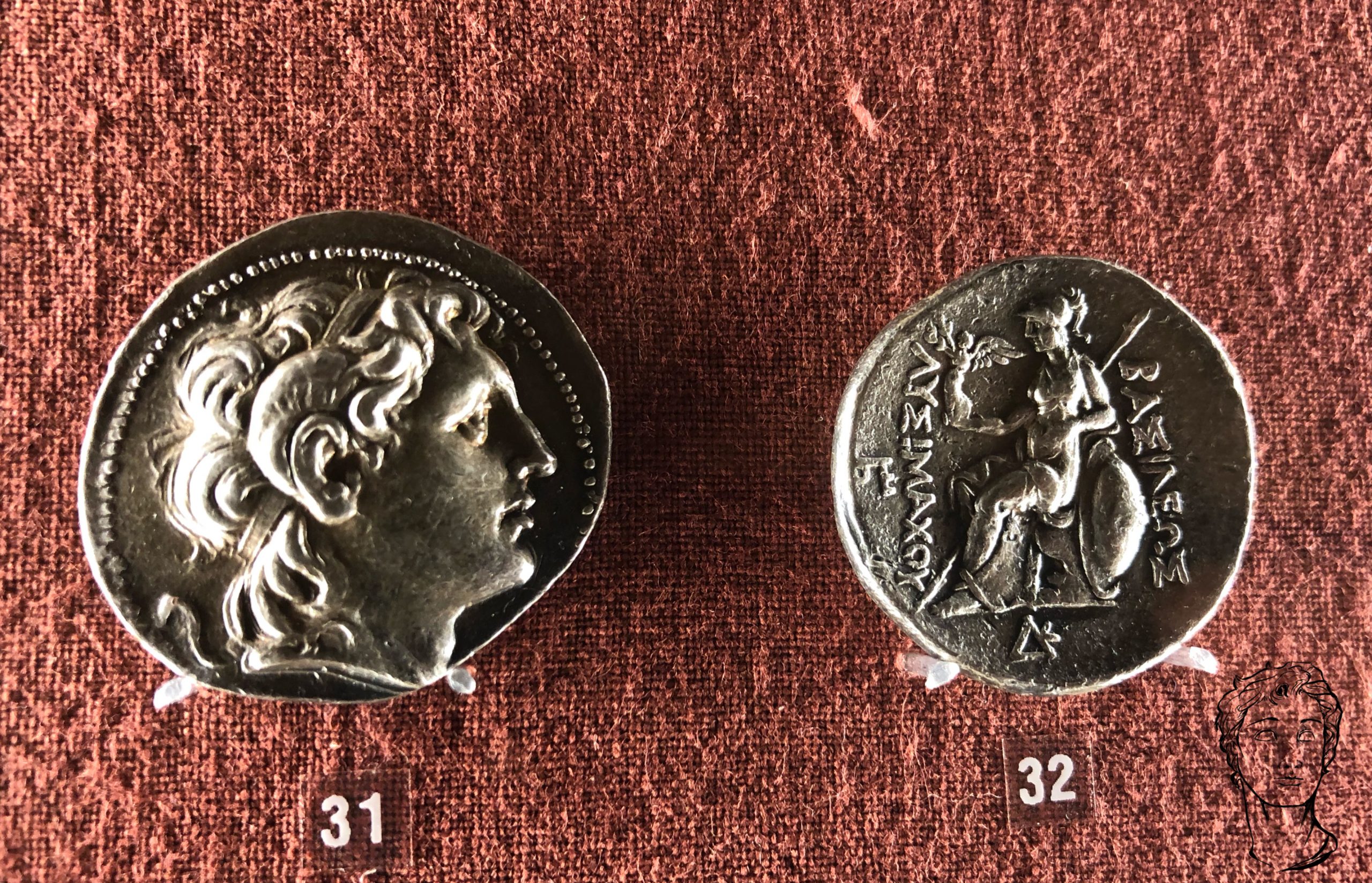To writers like Herodotus and Ctesias, India was on the periphery of the Greek understanding of the inhabited world, drifting the between outright fantasy and the faintest tidbits of reality. Though the invasion of Alexander the Great and the Macedonian army into the Punjab in 327 BC was something of a bloody introduction, it marked a radical shift in the level of interaction between the cultures of Greece and India, which would continue throughout the Hellenistic period. Today’s Guest writer Derek – from the brilliant Hellenistic Age Podcast – shines some much needed light on the interactions between these two cultures.
 Alexander’s empire would not last beyond his death, neither among his generals nor in distant India. While the Successors would duke it out and carve out their own kingdoms, India was undergoing a radical change in the political landscape thanks to an ambitious and talented young leader named Chandragupta Maurya (r. 321-295 BC) who forged an empire that united much of the subcontinent. The first meeting between the Hellenistic kings and Chandragupta was far from peaceful. Seleucus I Nicator (r.312-281), founder of the Syrian-based dynasty that bears his name, had embarked on a campaign of reconquest and consolidation of several of Alexander’s eastern satrapies between 306-303 BC [Appian, Syrian Wars, 55; Strabo 15.2.9; Justin 15.4.21]. By 305, Seleucus took an army across the Indus River and clashed with the forces of Chandragupta. We know almost nothing about the war, but some two years later a peace treaty was signed between the two parties that put an end to the fighting.
Alexander’s empire would not last beyond his death, neither among his generals nor in distant India. While the Successors would duke it out and carve out their own kingdoms, India was undergoing a radical change in the political landscape thanks to an ambitious and talented young leader named Chandragupta Maurya (r. 321-295 BC) who forged an empire that united much of the subcontinent. The first meeting between the Hellenistic kings and Chandragupta was far from peaceful. Seleucus I Nicator (r.312-281), founder of the Syrian-based dynasty that bears his name, had embarked on a campaign of reconquest and consolidation of several of Alexander’s eastern satrapies between 306-303 BC [Appian, Syrian Wars, 55; Strabo 15.2.9; Justin 15.4.21]. By 305, Seleucus took an army across the Indus River and clashed with the forces of Chandragupta. We know almost nothing about the war, but some two years later a peace treaty was signed between the two parties that put an end to the fighting.
The treaty itself seems to have three clauses: the first was a marriage alliance between the Seleucid and Mauryan dynasties, thought to have been either Chandragupta taking a Seleucid bride or an affirmation of the marriage rights between the Greek colonists and local Indian communities. The Greeks, being casteless Yavana (the Sanskrit word for “Ionian”, i.e. Greek), would otherwise be legally barred or at least be restricted from taking Indian wives [Kosmin, 32-34; Mairs, 111-112; Stoneman, 378-379]. The second would be the transfer of Seleucus’ easternmost territories like Gandhara and Arachosia to Chandraupta. Thirdly, Chandragupta would give 500 Indian Elephants (and, presumably, their handlers) that were trained for use in battle. The relatively unbalanced transfer suggests that the war may have ended in Chandragupta’s favor, but the elephants would play an invaluable role that helped determine the outcome of the Battle of Ipsus in 301 BC. A victory largely won by Seleucus’ generalship and use of elephants, which earned him the mocking nickname “Elephant King” [Plutarch, Dem. 25.4].
The Treaty on the Indus thus established a firm border between the Seleucids and the Maurya and inaugurated a period of peaceful diplomacy lasting for over a century between the Successor Kingdoms and the Mauryan Empire. We have a few individual anecdotes of gift-exchanges between both parties. Chandragupta had some of India’s flora and fauna delivered to Seleucus: specimens like plants acting as aphrodisiacs or anaphrodisiacs, and even a tiger, which Seleucus regifted to Athens much to the amazement of its populace [Athenaeus, 1.32, 13.57]. Conversely, Chandragupta’s successor Bindusara sent a “wish list” to Antiochus I, requesting wine, figs, and a philosopher. The first two were duly returned, but Antiochus declined the request for a philosopher on the grounds that it was “unlawful” [Athenaeus, 14.67]. This pattern of gift giving seems to have carried on even as the Mauryan Empire began to fragment. For when Antiochus III marched to India he reaffirmed a friendship with King Sophagasenus (Subhagasena), presumably an independent lord or a subordinate rajah of the Maurya, and 150 elephants were gifted to the Seleucid ruler [Polybius, 11.34]. Such exchanges and negotiations indicate a relationship of equals, rather than that of coercion and domination [Kosmin, 35].
Not only were gifts exchanged, but we also have records of diplomats moving between the Seleucid and Mauryan courts throughout the period. In the time of Bindusara, the Seleucids sent Daimachus of Platea, while Ptolemy II Philadelphus commissioned an agent named Dionysius to travel on his behalf. [Strabo, 2.1.9; Pliny, 6.21]. However, the most important and influential of all the Greek diplomats would be Megasthenes, a Seleucid official who would journey to the court of Chandragupta in the great city of Pataliputra (modern Patna) along the Ganges River around the turn of the 4th century. We know little about the man, but his extended stay in Pataliputra enabled him to document his observations in a work known simply as the Indica. Sadly, the work does not survive outside of quotations by later authors like Strabo and Pliny the Elder, and despite some criticisms from near-contemporary writers, it has been considered one of the most detailed and accurate writings on India from an outside source until the Medieval period. [For more, see Stoneman, 129-285].
Megasthenes described everything he could, ranging from the geography of the Ganges to the capture of elephants, and the inner workings of the Mauryan state. The purpose of the Indica has been debated, with some postulating that it was Megasthenes’ attempt to justify Seleucus’ withdrawal from India, while others argue that it was a form of field research in case the Seleucids decided to launch another invasion [Kosmin, 36-58; Kurht, A. and Sherwin-White, S., 97]. Whatever the case may be, it has proven to be of such value that many scholars continue to use it to reconstruct our knowledge on the Mauryan Empire by cross-examining it with another work of Indian origin, the Arthashastra, a treatise on statecraft traditionally thought to have been composed by Chandragupta’s political advisor Chanakya [Avari, 107-110; Jansari, 40-41]

So far, most our sources on Greco-Indian diplomacy comes from Greek writers and historians. But one of the most interesting and tantalizing accounts comes from none other than the third Mauryan Emperor: Ashoka the Great. Ashoka was originally an extremely warlike ruler, but following his particularly violent conquest of the Kalingas along the western portion of the Bay of Bengal in the 260s BC, he became a prominent convert to Buddhism. To express his newfound faith and outlook on life, Ashoka ordered dozens of inscriptions to be carved into stone across the entirety of his empire, telling us as much about Ashoka’s spiritual journey as it laid down the tenets of his beliefs [Lahiri, 118-279]. Two of them are especially relevant: Edict VII, recovered in 1957 from Kandahar, Afghanistan, discusses the philosophy behind nonviolence and urges a halt or restriction on hunting and fishing [For the translation see Imaging, 2012]. The inscription was carved in two languages, Aramaic (the lingua franca for much of the Iranian Plateau and Near East) and Greek, indicating a significant population of Greeks living within Mauryan borders.

The other important example is Edict XIII, where Ashoka demonstrates his commitment to spreading the teachings of the Dharma by sending emissaries to the great kings of the West: Antiyoga (Antiochus I/II of the Seleucid Empire), Tulamaya (Ptolemy II Philadelphus of Egypt), Antekina (Antigonus II Gonatas of Macedon), Maka (Magas of Cyrene), and Alikyashudala (Alexander II of Epirus) [Hultzsch, 43-49]. Not only does it reflect Ashoka’s understanding of the political landscape of the mid-3rd century Mediterranean, but it also provides us one of the few tantalizing pieces of evidence that Buddhist missionaries were sent to the Greek-speaking world, although we have no other accounts of their journey or their fate.
The political fragmentation of the Mauryan Empire following Ashoka’s death in 232 BC coincides with the gradual loss of Seleucid Central Asia. Byy 185 BC the Maurya dynasty would disappear, while the Seleucids found themselves increasingly restricted to Syria and the Near East. The time of embassies and gift-exchange between India and the Mediterranean powers would largely come to an end, though trade networks continued to flourish. Conversely, the collapse of Mauryan power created a power vacuum that the ambitious kings of Greco-Bactria were quick to fill. In the same vein as Alexander and Seleucus, Demetrius I (r. 200-180 BC) would invade the subcontinent and establish the so-called Indo-Greek kingdoms in northwest India and Pakistan, ushering in a new (and perhaps less peaceful) era of exchange and interaction.
References and further reading
Avari, B. (2007) India: The Ancient Past, A History of the Indian sub-continent from c. 7000 BC to AD 1200.
Grainger, J.D. (2014)The Rise of the Seleukid Empire, 323-223 BC.
Hultzsch, E. ( 1925) Inscriptions of Asoka, New Edition.
Jansari, S. (2020) “Chapter 3: South Asia” in Mairs, R., The Graeco-Bactrian and Indo-Greek World.
Kosmin, P.J. (2014) The Land of the Elephant Kings: Space, Territory, and Ideology in the Seleucid Empire.
Kurht, A. and Sherwin-White, S. (1993) From Samarkand to Sardis: A New Approach to the Seleucid Empire.
Imaging, W. (2012, April 26). Greek and Aramaic inscriptions by king Ashoka. World History Encyclopedia.
Lahiri, N. (2015) Ashoka in Ancient India.
Mairs, R. (2014) The Hellenistic Far East: Archaeology, Language, and Identity in Greek Central Asia.
Stoneman, R. (2019) The Greek Experience of India: From Alexander to the Indo-Greeks.


 Can’t get enough of the Hellenistic Age? I would highly recommend listening to Derek’s podcast: the
Can’t get enough of the Hellenistic Age? I would highly recommend listening to Derek’s podcast: the 
